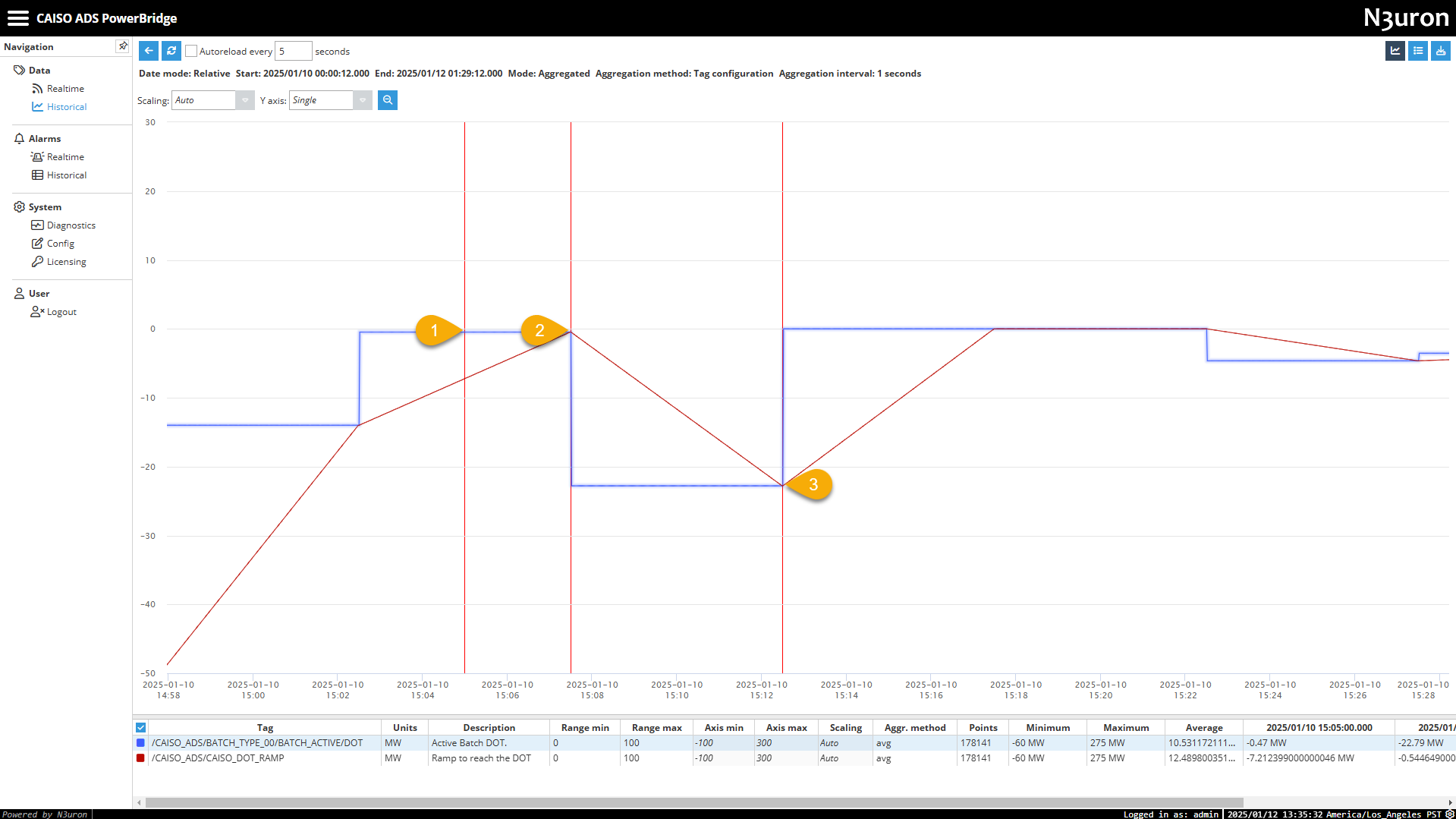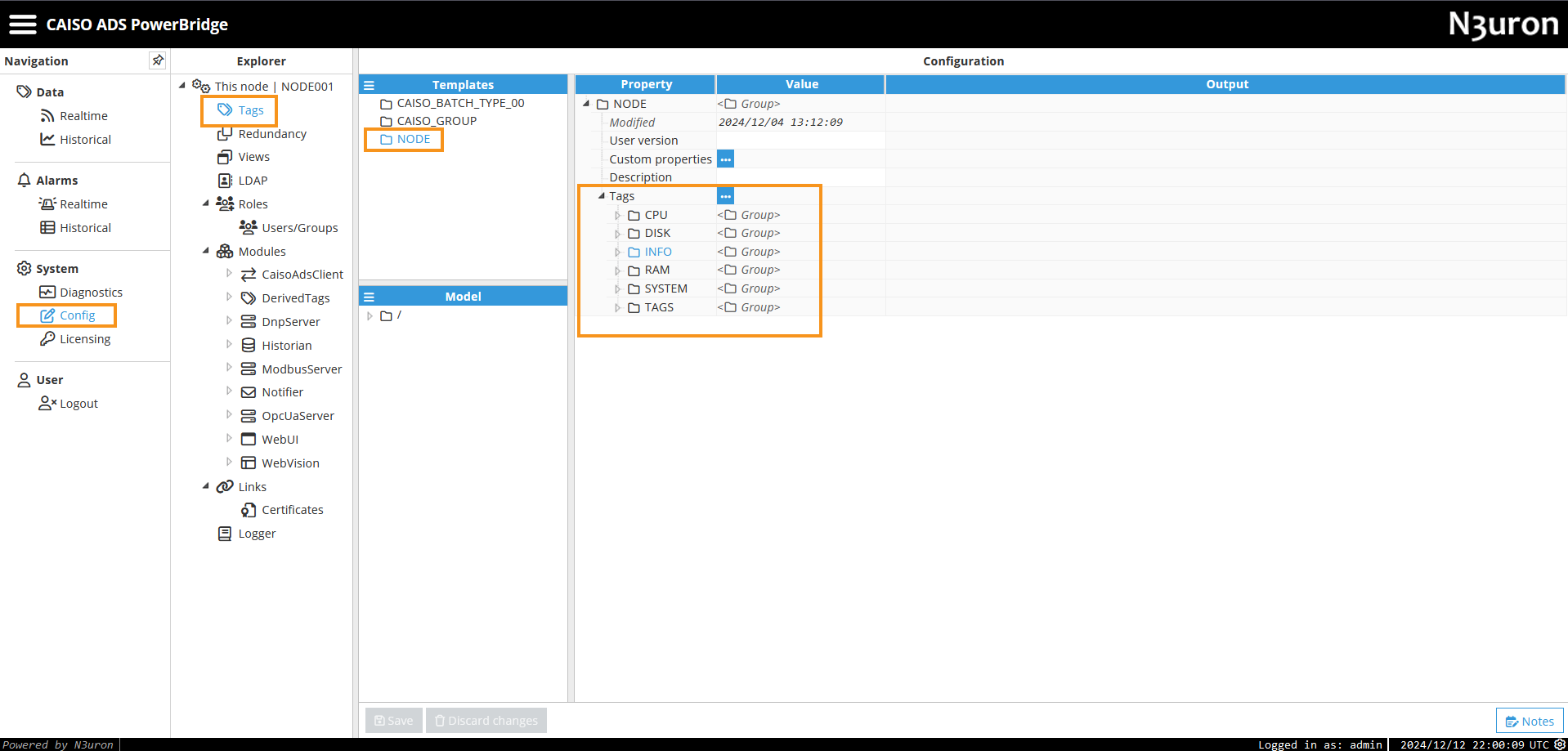The CAISO ADS PowerBridge data model is preconfigured for 5-minute dispatchable batches (Batch Type 0), the most commonly used setup. To address diverse operational requirements, the CAISO ADS Client also supports additional batch types, including:
AS Awards
5-Minute Flex Ramp Award
Unannounced AS Test
For more details, refer to the CAISO ADS Tag Configuration section.
The CAISO ADS PowerBridge relies heavily on Templates to simplify project deployment and maintenance. This project specifically includes three templates: CAISO_BATCH_TYPE_00, CAISO_GROUP, and NODE. Each template serves a distinct purpose, and their details are outlined below.
CAISO_BATCH_TYPE_00 Template
.png)
Custom Properties
Batch_type: Specifies the batch type.
0) 5 minute dispatchable.
3) AS awards.
10) 5-minute flex ramp award.
12) Unannounced AS test.
Client: Identifies the client acting as the data provider for the tags.
Historian_name: Specifies the Historian module instance responsible for data historization (e.g., "Historian").
Module_name: Identifies the CAISO ADS Client module instance providing the tag's data (e.g., "CaisoAdsClient").
Tag Groups
Tags are grouped into three states to represent different batch processing states.
Active: Currently active batch being processed.
Next: Upcoming batch scheduled after the active one.
Previous: Batch processed immediately before the active batch.
Note:
N3uron's CAISO ADS Client automatically assigns and rotates batches among these categories. This ensures that only one set of valid dispatch instructions is active at a time, enables the preparation and validation of upcoming batches in advance, and clearly distinguishes between older and newer instrunctions for efficient batch management.
BATCH_ACTIVE|NEXT|PREVIOUS Tag Groups
Note:
Tags in this group, shown in the table below, are configured as read-only and persist to disk, ensuring their values are retained after a system restart.
TAG NAME | TYPE | DESCRIPTION |
|---|---|---|
BATCH_EXPIRES | STRING | Timestamp indicating when the batch is no longer valid. |
BATCH_RECEIVED | STRING | Timestamp when the batch was received. |
BATCH_REVISION_NUMBER | UINT32 | Integer representing the version of the batch. |
BATCH_SENT | STRING | Timestamp indicating when the batch was sent. |
BATCH_START_TIME | STRING | The start time for the batch's effective period. |
BATCH_STATUS | UINT16 | Indicates the current status of the batch. |
BATCH_TYPE | UINT16 | Type or category of the batch. |
BATCH_UID | STRING | Unique identifier for the batch. |
BINDING_FLAG | STRING | Flag indicating whether the batch is binding (Y) or non-binding(empty). |
DISPATCH_MODE | UINT16 | Mode of dispatch for the batch (0 = Interval 1 = Manual 2 = Contingency). |
DOT | FLOAT64 | Batch DOT for 5 minutes. |
FOLLOW_DOT_FLAG | STRING | Indicates whether the system should follow the ramp dots |
INSTRUCTION_START_TIME | STRING | Start time of the dispatch instruction. |
MARKET_ID | UINT16 | Identifier for the market type. |
PREVIOUS_DOT | FLOAT64 | Previous DOT for 5 minutes. |
SUPP | FLOAT64 | Supplemental Energy instruction value. |
DNP_MODBUS_CONVERSIONS Tag Group
The tags in this group are organized into subgroups: BATCH_ACTIVE, and PREVIOUS. These tags convert timestamps received from CAISO ADS, formatted in ISO 8601 UTC format, into epoch timestamp values in seconds. This conversion simplifies processing and ensures compatibility with data types required by DNP and Modbus protocols.
Additionally, BINDING_FLAG and FOLLOW_DOT_FLAG are converted to Boolean data types. All transformations are performed using Derived Tags.
TAG NAME | TYPE | DESCRIPTION |
|---|---|---|
BATCH_EXPIRES | UINT32 | Timestamp indicating when the batch is no longer valid. |
BATCH_RECEIVED | UINT32 | Timestamp when the batch was received. |
BATCH_SENT | UINT32 | Timestamp indicating when the batch was sent. |
BATCH_START_TIME | UINT32 | The start time for the batch's effective period. |
BINDING_FLAG | BOOL | Flag indicating whether the batch is binding (Y) or non-binding(empty). |
DOT_TS | UINT32 | Timestamp of the DOT. |
FOLLOW_DOT_FLAG | BOOL | Indicates whether the system should follow the ramp dots provided in the batch if 'Y'. |
INSTRUCTION_START_TIME | UINT32 | Start time of the dispatch instruction. |
PREVIOUS_DOT_TS | UINT32 | Timestamp of the Previous DOT. |
CAISO_GROUP Template
.png)
This template consists of the following structure:
BATCH_TYPE_00: An instance of the CAISO_BATCH_TYPE_00 template.
CAISO_ADS_HOST_COMM_OK: A Boolean Derived Tag representing the communication status with the CAISO ADS Host. It periodically evaluates the quality of several tags in the active batch to detect potential communication loss.
CAISO_DOT_RAMP: A Derived Tag that calculates a DOT ramp to align with the DOT at the instruction start time specified by CAISO ADS. The built-in DOT Ramping function automatically calculates the gradient between the start and end targets, ensuring the DOT provided to the PPC ramps smoothly and accurately.
HEARTBEAT: The HEARTBEAT is a Derived Tag updated every second. It enables real-time external monitoring of the system's status and health.
The graph below illustrates how DOT Ramp Calculation works:
Instruction Received: At the midpoint of each batch interval, CAISO ADS sends a new instruction that includes both a DOT value and an Instruction Start Time.
Ramp Initiation: The DOT Ramp calculation begins at the Instruction Start Time.
Target Reached: The DOT Ramp is expected to reach the specified DOT target exactly 5 minutes after the Instruction Start Time.

NODE Template

The NODE Template is aimed at providing a comprehensive overview of the system's performance and operational metrics. It organizes information into specific Tag Groups, making it easier to monitor and manage critical aspects of the system. Below is a breakdown of each Tag Group and its purpose:
CPU: Provides information about CPU usage, enabling monitoring of processor performance and system load.
DISK: Displays information about disk usage, including storage capacity and utilization.
INFO: Contains various system details, including:
Bootstrap start time
Bootstrap version
N3uron Executable version.
Hostname
Node name
Process ID (PID)
Node uptime
RAM: Offers insights into RAM usage, assisting in the assessment of memory performance and allocation efficiency.
SYSTEM: Provides high-level system information, including:
System boot time
Current system time
System uptime
TAGS: Reports tag statistics, such as:
Number of local tags
Number of remote tags
Total tag count